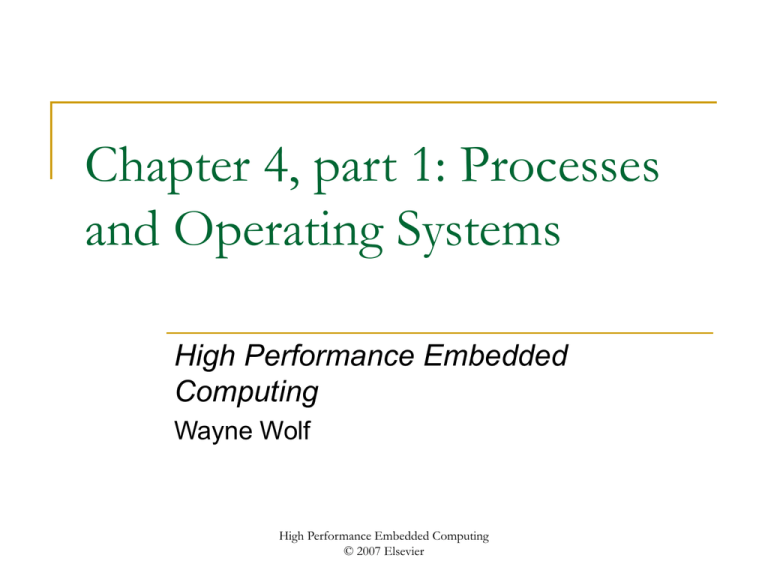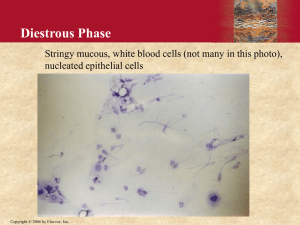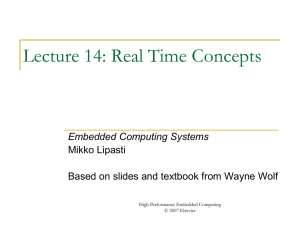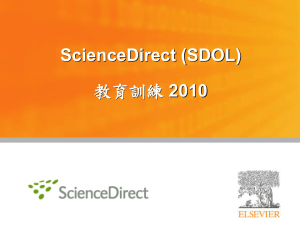Ch 4 - Part 1
advertisement

Chapter 4, part 1: Processes and Operating Systems High Performance Embedded Computing Wayne Wolf High Performance Embedded Computing © 2007 Elsevier Topics Real-time scheduling. Scheduling for power/energy. Languages and scheduling. © 2006 Elsevier Real-time scheduling terminology Process: unique execution of a program Context switch: operating system switch from one process to another. Time quantum: time between OS interrupts. Schedule: sequence of process executions or context switches. Thread: process that shares address space with other threads. Task: a collection of processes. Subtask: one process in a task. © 2006 Elsevier Real-time scheduling algorithms Static scheduling algorithms determine the schedule off-line. Constructive algorithms don’t have a complete schedule until the end of the algorithm. Iterative improvement algorithms build a schedule, then modify it. Dynamic scheduling algorithms build the schedule during system operation. Priority schedulers assign priorities to processes. Priorities may be static or dynamic. © 2006 Elsevier Timing requirements Real-time systems have timing requirements. Hard: missing a deadline causes system failure. Soft: missing a deadline does not cause failure. Deadline: time at which computation must finish. Release time: first time that computation may start. Period (T): interval between deadlines. Relative deadline: release time to deadline. © 2006 Elsevier Timing behavior Initiation time: time when process actually starts executing. Completion time: time when process finishes. Response time = completion time – release time. Execution time (C): amount of time required to run the process on the CPU. © 2006 Elsevier Utilization Total execution time C required to execute processes 1..n is the sum of the Cis for the processes. Given available time t, utilization U = C/t. Generally expressed as a percentage. CPU can’t deliver more than 100% utilization. © 2006 Elsevier Static scheduling algorithms Often take advantage of data dependencies. Resource dependencies come from the implementation. As-soon-as-possible (ASAP): schedule each process as soon as data dependencies allow. As-late-as-possible (ALAP): schedule each process as late as data dependencies and deadlines allow. © 2006 Elsevier List scheduling A common form of constructive scheduler. © 2006 Elsevier Interval scheduling Chou and Borriello: statically schedule deadline-driven operations. Processes and timing constraints represented by weighted directed graph. Constructive algorithm formulated recursively. Partial schedule is valid at each step. © 2006 Elsevier [Cho95a] © 1995 ACM Press Priority-driven scheduling Each process has a priority. Processes may be ready or waiting. Highest-priority ready process runs in the current quantum. Priorities may be static or dynamic. © 2006 Elsevier Rate-monotonic scheduling Liu and Layland: proved properties of static priority scheduling. No data dependencies between processes. Process periods may have arbitrary relationships. Ideal (zero) context switching time. Release time of process is start of period. Process execution time is fixed. © 2006 Elsevier Critical instant © 2006 Elsevier Critical instant analysis Process 1 has shorter period, process 2 has longer period. If process 2 has higher priority, then: Schedulability condition: Utilization is: Utilization approaches: © 2006 Elsevier Earliest-deadline-first (EDF) scheduling Liu and Layland: dynamic priority algorithm. Process closest to its deadline has highest priority. Relative deadline D. Process set must satisfy: © 2006 Elsevier Least-laxity-first (LLF) scheduling Laxity or slack: difference between remaining computation time and time until deadline. Process with smallest laxity has highest priority. Unlike EDF, takes into account computation time in addition to deadline. © 2006 Elsevier Priority inversion RMS and EDF assume no dependencies or outside resources. When processes use external resources, scheduling must take those into account. Priority inversion: external resources can make a low-priority process continue to execute as if it had higher priority. © 2006 Elsevier Priority inversion example © 2006 Elsevier Priority inheritance protocols Sha et al.: basic priority inheritance protocol, priority ceiling protocol. Process in a critical section executes at highest priority of any process that shares that critical section. Priority ceiling protocol: each semaphore has its own priority ceiling. Can deadlock. Required priority to obtain semaphore depends on priorities of other locked semaphores. Schedulability: © 2006 Elsevier Scheduling for dynamic voltage scaling Dynamic voltage scaling (DVS): change processor voltage to save power. Power consumption goes down as V2, performance goes down as V. Must make sure that the process finishes its deadline. © 2006 Elsevier Yao et al. DVS for real-time Intensity of an interval defines lower bound on average speed required to create a feasible schedule. Interval that maximizes the intensity is the critical interval. Optimal schedule is equal to the intensity of the critical interval. Average rate heuristic: © 2006 Elsevier DVS with discrete voltages Ishihara and Yasuura: two voltage levels are sufficient if a finite set of discrete voltage levels are used. © 2006 Elsevier Voltage scaling with two voltages © 2006 Elsevier [Ish98a] © 1998 IEEE Kim et al. slack-based scheduling © 2006 Elsevier [Kim02] © 2002 IEEE Checkpoint-driven scheduling Azevedo et al. used profile data to guide DVS. Designer inserts checkpoints in program to measure performance and energy. Scheduler considers all possible events from current checkpoint to deadline. © 2006 Elsevier[Aze03] © 2002 IEEE Computer Society Procrastination scheduling Family of algorithms that maximizes lengths of idle periods. CPU can be turned off during idle periods, further reducing energy consumption. Jejurkar et al.: Power consumption P = PAC + PDC + Pon. Minimum breakeven time tth = Esd/Pidle. Guarantees deadlines if: © 2006 Elsevier Performance estimation Multiple processes interfere in the cache. Single-process performance evaluation cannot take into account the effects of a dynamic schedule. Kirk and Strosnider: segment the cache, allow processes to lock themselves into a segment. Mueller: use software methods to partition. © 2006 Elsevier Cache modeling and scheduling Li and Wolf: each process has a stable footprint in the cache. Two-state model: Process is in the cache. Process is not in the cache. Characterize execution time in each state off-line. Use CPU time measurements along with cache state to estimate process performance at each quantum. Kastner and Thiesing: scheduling algorithm takes cache state into account. © 2006 Elsevier Languages and scheduling Programming language can capture information about tasks. Compilation can generate specialized implementations, implement static schedules. © 2006 Elsevier Codesign finite state machines (CFSMs) Control model for hardware and software. Four-state execution: Idle. Detect input events. Go to new state based on current state and inputs. Emit outputs. Chiodo et al. compiled by generating an sgraph. Analyze with Shannon decomposition. © 2006 Elsevier Lin and Zhu static scheduling using Petri nets Find maximal acyclic fragments of program, schedule operations in each fragment. Expansion of a Petri net: acyclic Petri net in which every transition has one input or output or output place, no input transitions, and at least one place with no output transitions. Maximal expansion is transitively closed. Code is generated form maximally expanded fragment by pre-ordering operations. © 2006 Elsevier Maximal expansions © 2006 Elsevier [Lin98] © 1998 IEEE Computer Society Software thread integration Dean: schedule multiple threads statically in a single program. Primary thread has real-time requirements. Secondary thread does not have real-time requirements. © 2006 Elsevier Software thread integration and CDGs Thread is represented as control dependence graph (CDG). Annotated with execution times of each blocks. Code from primary thread must be replicated in secondary thread to be sure that it is executed along every path. Insertion points must meet primary thread deadlines. © 2006 Elsevier Giotto Language for describing concurrent systems. Execution is organized into modes: repeated invocation of a sequence of tasks in a fixed order. Single invocation is a round. © 2006 Elsevier Giotto execution cycle 1. 2. 3. 4. 5. 6. 7. 8. 9. Task output and internal ports are updated. Actuator ports are updated. Sensor ports are updated. Modes are updated, possibly selecting some target modes. Mode ports are updated. Mode time is updated. Task input ports are updated. Set of active tasks is updated. Time clock is updated. © 2006 Elsevier SHIM Programming model connects sequential processes through fixed communication channels. Processes communicate with rendezvous (no buffers). Model is deterministic. SHIM specifications can be implemented in single thread using Lin/Zhu algorithm. © 2006 Elsevier







